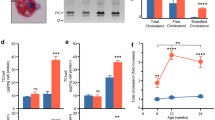Abstract
Amiodarone can cause pulmonary toxicity along with an increase in phospholipid in macrophages, lymphocytes, and other cell types. Phospholipid accumulates because amiodarone inhibits the lysosomal phospholipases A1 and A2. Since a wide array of cells are affected by amiodarone and because amiodarone might inhibit other phospholipases, we postulated that cellular functions might be affected. Therefore, the major focus of this study was to determine whether amiodarone inhibited cellular functions. We found that alveolar macrophages isolated from drug-fed rats were significantly less phagocytic, and that the rats had significantly depressed delayed-type hypersensitivity responses. Spleen cells isolated from the drug-fed rats also had severely depressed mitogen responses. Since the spleen cell proliferative response could be partially restored by stimulating the cells with ionomycin and phorbol myristate acetate, we postulated that amiodarone was inhibiting phospholipase C. To substantiate this hypothesis, we found that amiodarone could directly inhibit phospholipase C in vitro. We conclude that amiodarone affects both phagocytic responses and the development of cell-mediated immunity and that the lack of these normal responses could exacerbate amiodarone toxicity. One possible mechanism for decreased cellular functions may be the inhibition of phospholipase C. However, further studies are necessary to confirm this finding.
Similar content being viewed by others
References
Akoun GM, Gauthier-Rahman S, Liote HA, Milleron BJ, Mayaud CM (1988) Leukocyte migration inhibition in amiodarone-associated pneumonitis. Chest 94:1050–1053
Allen EM, Moore VL (1979) Suppression of phytohemagglutinin and lipopolysaccharide responses in mouse spleen cells by bacillus Calmette-Guerin. J Reticuloendothel Soc 26:349–356
Bergmeyer HU, Bernt E, Hess B (1965) Lactate dehydrogenase. In: Bergmeyer HU (ed) Methods in enzymatic analysis. Academic Press, New York, pp 736–743
Burger A, Dinichert D, Nicod P, Jenny M, Lemarchand-Beraud T, Ballotton MB (1976) Effect of amiodarone on srum triiodothyronine, reverse triiodothyronine, thyroxin, and thyrotropin. J Clin Invest 58:255–259
Chuang DM (1989) Neurotransmitter receptors and phosphoinositide turnover. Annu Rev Pharmacol Toxicol 29:71–110
Dake MD, Madison JM, Montgomery CK, Shellito JD, Hinchcliffe WA, Winkle ML, Bainton DF (1985) Electron microscopic demonstration of lysosomal inclusion bodies in lung, liver, lymph nodes, and blood leukocytes of patients with amiodarone pulmonary toxicity. Am J Med 78:506–512
D'Amico DJ, Kenyon KR, Ruskin JN (1981) Amiodarone keratopathy: Drug-induced lipid storage disease. Arch Ophthalmol 99:261–275
Feiner LA, Younge BR, Kazmier FK, Stricler BH, Fraunfelder FT (1987) Optic neuropathy and amiodarone therapy. Mayo Clin Proc 62:702–717
Fogoros RN, Anderson KP, Winkle RA, Swerdlow CD, Mason JW (1983) Amiodarone clinical efficacy and toxicity in 96 patients with recurrent, drug-refractory arrhythmias. Circulation 68:88–94
Haffajee CI, Love JC, Canada AT, Lesko LJ, Asdourian G, Alpert JS (1983) Clinical pharmacokinetics and efficacy of amiodarone for refractory tachyarrhythmias. Circulation 67:1347–1355
Harris L, McKenna WJ, Rowland E, Krikler DM (1983) Side effects and possible contraindications of amiodarone use. Am Heart J 106:916–923
Henningsen GM, Koller LD, Exon LH, Talcott PA, Osborne CA (1984) A sensitive delayed-type hypersensitivity model in the rat for assessing in vivo cell-mediated immunity. J Immunol Methods 70:153–165
Hostetler KY, Reasor MJ, Walker ER, Yazaki PJ, Frazee BW (1986) Role of phospholipase A inhibition in amiodarone pulmonary toxicity in rats. Biochim Biophys Acta 875:400–405
Hostetler KY, Giordano JR, Jellison EJ (1988) In vitro inhibition of lysosomal phospholipase Al of rat lung by amiodarone and desethylamiodarone. Biochim Biophys Acta 959:316–321
Israel-Biet D, Venet A, Caubarrere I, Bonan G, Danel C, Chretien J, Hance AJ (1987) Bronchoalveolar lavage in amiodarone pneumonitis. Cellular abnormalities and their relevance to pathogenesis. Chest 91:214–221
Mackin WM, Stevens TM (1988) Biochemical and pharmacologic characterization of a phosphatidylinositol-specific phospholipase C in rat neutrophils. J Leukocyte Biol 44:8–16
Martin WJ (1990) Mechanisms of amiodarone pulmonary toxicity. Clin Chest Med 11:131–138
Martin WJ, Kachel DL, Vilen T, Natarajan V (1989) Mechanism of phospholipidosis in amiodarone pulmonary toxicity. J Pharmacol Exp Ther 251:272–278
Martin WJ, Standing JE (1987) Amiodarone pulmonary toxicity. Biochemical evidence for a cellular phospholipidosis in the bronchoalveolar lavage of human subjects. J Pharmacol Exp Ther 244:774–779
McGovern B, Garan H, Kelly E, Ruskin JN (1983) Adverse reactions during treatment with amiodarone hydrochloride. Br Med J 287:175–180
Poucell S, Ireton J, Balencia-Mayoral P, Downar E, Larratt L, Patterson J, Blendis L, Phillips MJ (1984) Amiodarone-associated phospholipidosis and fibrosis of the liver. Gastroenterology 86:926–936
Raeder EA, Podrid PJ, Lown B (1983) Side effects and complications' of amiodarone therapy. Am Hearing J 109:975–983
Reasor MJ, Ogle CL, Kacew S (1989) Amiodarone-induced pulmonary toxicity in rats: biochemical and pharmacological characteristics. Toxicol Appl Pharmacol 97:124–133
Reasor MJ, Ogle CL, Walker ER, Kacew S (1988) Amiodarone-induced phospholipidosis in rat alveolar macrophages. Am Rev Respir Dis 137:510–518
Rittenhouse SE (1982) Preparation of selectively labeled phosphatidylinositol and assay of phosphatidylinositol specific phospholipase C. Methods Enzymol 86:3–11
Sauers LJ, Wierda D, Reasor MJ (1988) Chlorphentermine suppresses the phosphatidylinositol pathway in concanavalin A-activated mouse splenic lymphocytes. Immunopharmacol Immunotoxicol 10:1–19
Wilson BD, Clarkson CE, Lippmann ML (1991) Amiodarone-induced pulmonary inflammation. Correlation with drug dose and lung levels of drug, metabolite and phospholipid. Am Rev Respir Dis 143:1110–1114
Wilson BD, Jaworski AJ, Donner ME, Lippmann ML (1989) Amiodarone-induced pulmonary toxicity in the rat. Lung 167:301–311
Wilson BD, Lippmann ML (1990) Pulmonary accumulation of amiodarone and N-desethylamiodarone. Relationship to the development of pulmonary toxicity. Am Rev Respir Dis 141:1553–1558
Author information
Authors and Affiliations
Additional information
Offprint requests to: B. D. Wilson, Albert Einstein Medical Center
Rights and permissions
About this article
Cite this article
Wilson, B.D., Clarkson, C.E. & Lippmann, M.L. Amiodarone causes decreased cell-mediated immune responses and inhibits the phospholipase C signaling pathway. Lung 171, 137–148 (1993). https://doi.org/10.1007/BF00183943
Accepted:
Issue Date:
DOI: https://doi.org/10.1007/BF00183943




